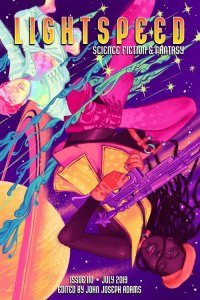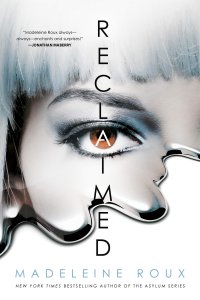Karen Burnham Reviews Short Fiction: Lightspeed, New York Times, Tor.com, Big Echo, and Terraform
 Lightspeed 7/19
Lightspeed 7/19
New York Times 5/27/19
Tor.com 6/5/19
Big Echo 1/19
Terraform 5/13/19
The science fiction stories in July’s Lightspeed catch characters at very different phases of their lives. “The Null Space Conundrum” by Violet Allen is an over-the-top story of Aria, a supercool (and very self-conscious about that coolness) cosmic cyborg entity helping the living song entity Kantikle on a mission to save the Universe from a destructive force. They are cooped up on a spaceship and getting on each other’s nerves, and things get really trippy when weird mind-warping weaponry comes into play. Whether you find this story fabulous or annoying will hinge on how much you appreciate Aria’s super-arch tone as the viewpoint character. In “Miles and Miles and Miles“, by contrast, Andrew Penn Romine gives us Noah Stubbs, a down-on-his-luck Moon resident who gets involved in scams of varying levels of illegality as his wife dies from cancer, likely due to the increased-radiation environment. As it seems like Noah is skipping back and forth in time, it becomes clear that he’s suffering from dementia, possibly accelerated by that same radiation’s effect on his brain. His disorientation, sometimes becoming violent, and the concern of those around him, is palpable.
The New York Times invited Ted Chiang to submit an Op Ed from the future, and he delivered. “It’s 2059, and the Rich Kids Are Still Winning” appeared in May. The premise is that genetic engineering has allowed wealthy parents to boost their children’s intelligence. In an effort to balance the scales, some poorer children were given the same enhancements, but no other assistance. Unsurprisingly, they did not come close to achieving the same educational or life outcomes as the enhanced rich kids. Chiang points out just how much the scales are weighted towards the affluent, as they can invest resources into any of their kids’ ventures, multiplying the potential that is already there. This is a punchy piece that cuts right through a huge swath of comforting myths we tell ourselves about living in a meritocratic society.
The publisher Tor approached the end of an era this spring as it finally moved out of the Flatiron Building, its long-time home in New York. In June Seanan McGuire provided a fitting tribute for Tor.com in the fun steampunk story “Any Way the Wind Blows“. Her Majesty’s Stalwart Trumpet of Glory, affectionately known as Stubby, is a dimension-hopping airship out to survey parallel universes, focused on New York. Many versions of New York have a version of the Flatiron Building, it turns out, so there’s no way of knowing who might be inside when the scouts go to investigate. Captain Isabelle Langford has been out on mission for a long time and is heartily looking forward to being done with her tour; we also get to meet several of the entertainingly diverse beings that make up Stubby’s crew. The Captain doesn’t particularly appreciate it when she’s called down to vouch for her away team, but it’s entirely necessary to assure the building’s inhabitants that they’re not just fans in town for a convention. This is shameless fan service, all in good fun and well executed.
Big Echo‘s eleventh issue labels itself the “SF and Religion” issue, although, based on the four original stories here, I might have said philosophy rather than religion. It starts with “It Is a Rare Thing the Emperor Requireth” by Wm Henry Morris. The narrator is a scout from a deeply religious society, who has been captured by aliens. He can only communicate with one of them, the Weaver, via a gestural language that they develop together. This means they have a limited vocabulary and miss each other’s nuances; it’s very realistic but also quite a bit more challenging to read than the average “universal translator” style of SF. The captive is forced to create stories that his alien companion then weaves into silks; these are then ingested in some way by the Emperor. During the course of the story the captive tries to figure out to what extent he can subvert the Emperor by what he includes in his stories; then he starts to be more concerned for the physical and spiritual well-being of the Weaver. This is a story about different modes of communication and how vast gulfs between cultures and individuals might be spanned.
“Famous as the Moon” by Ethan Mills is a delightful story of a planet where Buddhist monks have recreated the personas of the world’s great philosophers to stage public debates for the edification of all. The author obviously had a great deal of fun imagining scenes such as a Acharya Vasubandhu vs. Bertrand Russell showdown. The plot involves some of the AIs going rogue and ceasing to provide life support for different parts of the complex. Josel Hamsa is an expert summoned from off-world to work on the problem discreetly. It turns out the AIs have made a momentous discovery out in the Ether – one which is challenging their own notions of reality – that is appropriate for any consciousness trained to think about the really big picture questions. Hamsa has to figure out a way to convince them back to their duties. “When I See the Skylark Rise” by A.J. Hammer also sends consciousnesses out into the void in search of the ineffable. In this universe, starships carry Seers to let the crews know if they’re about to be caught in a catastrophe. The Captain of the Lauzeta learns from her Seer that if she lands on the planet Ortyon, not just her crew will die, but a huge swath of the planet’s population as well. She does the right thing and stays away, even though her ship doesn’t have enough food or fuel to get to any other port. As the crew makes their preparations for the end, the Seer decides to send her consciousness farther out into that realm where her visions come from, either to end her life that way or to find help out in the transcendent void. The final story is a short parable, translated by Toshiya Kamei from the original Spanish, “New Testament” by Fernando Schekaiban. This piece of eschatological flash fiction imagines Man at the height of His potential greatness, which is also the End of the Universe. It reminded me a little bit of Isaac Asimov’s “The Last Question”, although Schekaiban’s story/Kamei’s translation is quite a bit more poetic.
In Terraform in May I particularly appreciated their publication of the first section of the story “The Training Commission” by Ingrid Burrington & Brendan Byrne. After reading the first chapter on Terraform, I signed up for their newsletter, where I received the rest of the story in installments over a few weeks. The story is told by emails and newsletter entries from freelance architectural journalist Aiofe, writing in 2038 in the aftermath of a second American Civil War, colloquially known as the National Shitstorm. The country is now largely run by supposedly benign algorithms and there’s a Truth and Reconciliation process ongoing – of which the titular “Training Commission” is part. At the start of the story Aiofe is ambushed by a visceral re-enactment of her brother’s martyrdom as part of a Smithsonian exhibit on the Shitstorm, and she writes about it angrily for her newsletter followers, then in emails with other journalists, her sister, and mother. The plot turns thriller as she is handed an old-fashioned USB drive by a man at the Smithsonian, who later turns up dead in the Potomac. I enjoyed it enough, and especially appreciated the worldbuilding enough, to stick with the whole run. I’d say the story suffered a little bit by being serialized; it was easy to forget some of the characters and relationships in the spaces between installments. I should admit, though, that the authors also posted a lot of supplementary material online that I didn’t have a chance to follow through on. This was definitely an interesting use of the newsletter format for storytelling, and I’d be interested to see more from this team.
Recommended Stories
“It’s 2059, and the Rich Kids Are Still Winning”, Ted Chiang (New York Times 5/27/19)
“It Is a Rare Thing the Emperor Requireth”, Wm Henry Morris (Big Echo 1/19)
Karen Burnham is an electromagnetics engineer by way of vocation, and a book reviewer/critic by way of avocation. She has worked on NASA projects including the Dream Chaser spacecraft and currently works in the automotive industry in Michigan. She has reviewed for venues such as Locus Magazine, NYRSF, Strange Horizons, SFSignal.com, and Cascadia Subduction Zone. She has produced podcasts for Locusmag.com and SFSignal.com, especially SF Crossing the Gulf with Karen Lord. Her book on Greg Egan came out from University of Illinois Press in 2014, and she has twice been nominated in the Best Non Fiction category of the British SF Awards.
This review and more like it in the August 2019 issue of Locus.
 While you are here, please take a moment to support Locus with a one-time or recurring donation. We rely on reader donations to keep the magazine and site going, and would like to keep the site paywall free, but WE NEED YOUR FINANCIAL SUPPORT to continue quality coverage of the science fiction and fantasy field.
While you are here, please take a moment to support Locus with a one-time or recurring donation. We rely on reader donations to keep the magazine and site going, and would like to keep the site paywall free, but WE NEED YOUR FINANCIAL SUPPORT to continue quality coverage of the science fiction and fantasy field.







